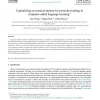Free Online Productivity Tools
i2Speak
i2Symbol
i2OCR
iTex2Img
iWeb2Print
iWeb2Shot
i2Type
iPdf2Split
iPdf2Merge
i2Bopomofo
i2Arabic
i2Style
i2Image
i2PDF
iLatex2Rtf
Sci2ools
CSL
2016
Springer
2016
Springer
Capitalizing on musical rhythm for prosodic training in computer-aided language learning
Language transfer creates a challenge for Chinese (L1) speakers in acquiring English (L2) rhythm. This appears to be a widely encountered difficulty among foreign learners of English, and is a major obstacle in acquiring a near-native oral proficiency. This paper presents a system named MusicSpeak, which strives to capitalize on musical rhythm for prosodic training in second language acquisition. This is one of the first efforts that develop an automatic procedure which can be applied to arbitrary English sentences, to cast rhythmic patterns in speech into rhythmic patterns in music. Learners can practice by speaking in synchrony with the musical rhythm. Evaluation results suggest that after practice, the learners’ speech generally achieves higher durational variability and better approximates stress-timed rhythm. © 2015 Published by Elsevier Ltd.
| Added | 01 Apr 2016 |
| Updated | 01 Apr 2016 |
| Type | Journal |
| Year | 2016 |
| Where | CSL |
| Authors | Hao Wang, Peggy Mok, Helen Meng |
Comments (0)

